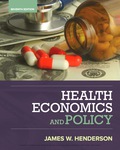
Surgeons’ ability in increasing the
Explanation of Solution
Surgeons have a higher ability in increasing the demand for surgeries as they attempt to increase the demand for their services that will increase their income. One of the most common surgeries unnecessarily prescribed by the doctors is bypasses. Sometimes even for the minor heart diseases some doctors tend to overprescribe the bypass that may lead towards more complicated medical issues. Women have been identified as the main victims of these unnecessarily prescribed surgeries. With rising demand for hysterectomies and caesarean sections surgeries, this has been evident. One of the most commonly prescribed unnecessary surgeries include removing of the uterus and other parts of the uterus that may lead towards complications in certain situations. In determining these unnecessarily prescribed surgeries, it is recommended that the patients seek opinion from another surgeon/doctor especially in the government sector as they serve the public with less purpose of making profits that is lacking in most of the private sector surgeons and doctors.
Introduction:
The objective of this study is to analyze the surgeons’ ability in increasing the demand for surgeries and the kinds of surgeries fall into this category and how to determine that they are unnecessary.
Want to see more full solutions like this?
Chapter 9 Solutions
EBK HEALTH ECONOMICS AND POLICY
- Suppose that a study finds that the price elasticity of demand for MRI's is 0.3 (in absolute value). If the price of care were to ___ by 3%, we would expect the quantity of preventative care consumed to fall by ____%. Suppose that a study finds that the price elasticity of demand for MRI's is 0.3 (in absolute value). If the price of care were to ___ by 3%, we would expect the quantity of preventative care consumed to fall by ____%. a. fall; 0.3% b. rise; 0.9% c. rise; 0.3% d. fall; 0.9%arrow_forwardWhat does price elasticity of demand mean for insurance companies and medical providers for making a decision?arrow_forwardDemand studies in health care have provided estimates of both income and price elasticity. Estimates of income elasticity are usually above +1.0. Estimates of price elasticity typically range between -0.1 and -.75 (with hospital services at the lower end and elective services at the upper end). What information do these estimates convey? What does the price elasticity of demand estimates imply for government policymakers, insurance companies, and medical providers' decisions? What does the income elasticity of demand estimates imply for government policymakers, insurance companies, and medical providers' decisions?arrow_forward
- Demand falls by 5 percent for every 10 percent increase in price health care services. How much is the won price elasticity of demand for health care?arrow_forwardWhat is the impact of aging societies like Japan and some other European countries on the demand for health services?arrow_forwardHow does the law of supply and demand apply to the growing success of the urgent care medical market in the United States?arrow_forward
- What is the significance when it comes to 3rd party payor to show it's efficient function of a medical market?arrow_forwardSuppose a household's income rose from 45k to 60k while their spending on health increased from 2k to 5k. 1. What is the income elasticity of demand for health? 2. What does this income elasticity of demand mean for this family?arrow_forwardThe price elasticity of demand for health care has been estimated to be −0.2. Characterize this demand as price elastic, unit price elastic, or price inelastic. The text argues that the greater the importance of an item in consumer budgets, the greater its elasticity. Health-care costs account for a relatively large share of household budgets. How could the price elasticity of demand for health care be such a small number?arrow_forward
- describe Diagnostic Research Designarrow_forwardDo countries with national health insurance programs have lower average medical costs than the United States? Is cost of care correlated with quality of care?arrow_forwardimprovement in technology usually result in lower cost of production or new and improved consumer goods and services .Assume that an improvement in medical technolgy result in an increase in life expectancy for people 65 years and older . How would this technolgical advance be likely to affect expenditure on health care?arrow_forward

 Exploring EconomicsEconomicsISBN:9781544336329Author:Robert L. SextonPublisher:SAGE Publications, Inc
Exploring EconomicsEconomicsISBN:9781544336329Author:Robert L. SextonPublisher:SAGE Publications, Inc

